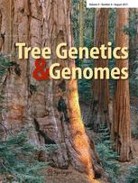Ver ítem
- xmlui.general.dspace_homeCentros Regionales y EEAsCentro Regional Patagonia NorteEEA BarilocheArtículos científicosxmlui.ArtifactBrowser.ItemViewer.trail
- Inicio
- Centros Regionales y EEAs
- Centro Regional Patagonia Norte
- EEA Bariloche
- Artículos científicos
- Ver ítem
Heritable variation in the survival of seedlings from Patagonian cypress marginal xeric populations coping with drought and extreme cold
Resumen
The rear edges of tree species have begun to be perceived as highly valuable for genetic resources conservation and management. In view of expected climatic changes, the responses of trees at their xeric limits may largely be determined by their capacity to cope with augmented environmental variance.We assess the heritability of early survival of Patagonian cypress in two common-garden
field tests with contrasting summer water deficits, comprising 140
[ver mas...]
The rear edges of tree species have begun to be perceived as highly valuable for genetic resources conservation and management. In view of expected climatic changes, the responses of trees at their xeric limits may largely be determined by their capacity to cope with augmented environmental variance.We assess the heritability of early survival of Patagonian cypress in two common-garden
field tests with contrasting summer water deficits, comprising 140 and 163 open-pollinated families from 10 marginal xeric populations. The first experiment underwent less rigorous conditions than the average mesic, Mediterranean climatic conditions, which were sufficient to reveal additive genetic effects of summer drought on seedling survival. The second trial suffered strong summer water-deficit stress and a winter extreme cold event. In this harsher environment, the heritabilities of survival under summer water-deficit stress were high in all the populations (h200.84 on average), while the heritabilities of seasonal, extreme cold survival were moderate or even nil (h200.28 on average). We did not find evidence of genetic differentiation among populations in their capabilities to survive droughts and cold extremes.
Our results indicate that even when climatic changes were strong enough to cause the extinction of the most threatened populations, heritable variation for traits underlying drought and cold tolerances may allow the marginal xeric edge of cypress to persist under augmented environmental variance, without losing overall genetic diversity.
[Cerrar]

Fuente
Tree Genetics & Genomes 8 : 801-810 (Enero 2012)
Fecha
2012-01
Editorial
Springer
ISSN
1614-2942
Formato
pdf
Tipo de documento
artículo
Palabras Claves
Derechos de acceso
Abierto
 Excepto donde se diga explicitamente, este item se publica bajo la siguiente descripción: Creative Commons Attribution-NonCommercial-ShareAlike 2.5 Unported (CC BY-NC-SA 2.5)
Excepto donde se diga explicitamente, este item se publica bajo la siguiente descripción: Creative Commons Attribution-NonCommercial-ShareAlike 2.5 Unported (CC BY-NC-SA 2.5)


